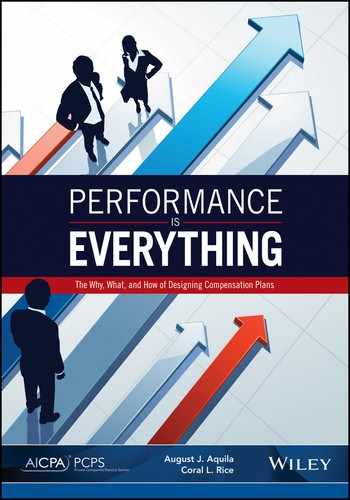15
What Will You Do Tomorrow?
“A journey of a thousand miles begins with a single step.”
—Lao Tzu
Congratulations! You have either finished reading the book or skimmed your way to the last chapter. No work is the last word, so ideas, suggestions, or comments are welcome. We would like to hear from you.
You can now select any number of paths, including
continuing to do what you have done, but please recognize you’ll continue to get the same results.
tweaking one or more of the elements of your performance management or compensation systems, but please know that tweaking creates a ripple effect that, over time, can cause even greater problems.
taking a holistic approach based on the ideas and advice shared in previous chapters to achieve the kind of results you may have only imagined.
To take this holistic approach and achieve a higher degree of performance, we identified in chapter 2, “Superior Performance Comes From Alignment,” nine variables that ultimately impact the firm’s performance. Making wholesale changes to these variables does not represent a silver bullet because we know there is no such thing; each firm is unique.
The best advice we can offer you is this:
Be open and honest with yourself and fellow owners about the reasons you want to make changes.
Show others how the future can be better if they embrace the changes; paint a picture rather than presenting a spreadsheet.
Spend time communicating with others, so they can share their issues, challenges, and concerns, as well as their hopes and dreams.
Let people know how they will share in the results.
Lead the way by personal example. They believe you based on your actions, not your words.
Act with a sense of urgency while acknowledging when things aren’t working.
Make needed adjustments in alignment with mission, vision, and values.
Be prepared to lose those who do not embrace the new modus operandi.
Remember that the journey is more important than the destination.
The future begins at this moment. While taking the preceding steps, be sure to keep the following in mind:
Change is hard for individuals and organizations. Too often, firm leaders believe they are embracing change by creating a committee to review the issues, but committees rarely create a sense of urgency. However, a strong leader who can rally a small group of visionaries can create a sense of urgency without stirring folks to a state of panic. You don’t want to create unnecessary tension; rather, you want to be realistic about results and how and when you want to see them.
You will be unable to make changes alone. A small group of visionaries is necessary, and the existing management or executive team may be too set in their ways. Take a look throughout the organization to find people with differing perspectives. Leadership often springs from the most unexpected places.
To make changes, you must be able to articulate the change and paint a picture of the future. You must also lay out the strategy to achieve this vision.
Communication will either make or break your change initiative. It must be clear, concise, transparent, often, and timely. Please don’t kill your change initiative, however, through “death by PowerPoint.” Your communications should be one on one (breakfasts, lunches, on the way to and from client meetings, and so on); small groups (departmental meetings and so on); and large groups (town halls, state of the state, dashboards, and so on). Think about the nine variables presented in chapter 2 that can help you improve performance and produce better results. Be sure you achieve short-term wins by starting with low-hanging fruit. When owners and employees get a few successes under their feet, they are less resistant to tackling more difficult tasks, challenges, or goals.
Change takes place in a firm to the degree everyone believes they have a part in making it happen. Not everything must go through the change committee or the CEO. Give people the power to act and take initiative.
Finally, you must never stop being the captain of, and cheerleader for, the initiative. The minute you give up or give in to old ways, the initiative dies.
Investing the time, resources, and efforts in developing a good performance management and reward system will provide your firm with a handsome return on the investment. It can give you a competitive edge in the marketplace and help you retain better performers. Remember, compensation is a strategic asset and needs to be used as such, and ultimately, performance is everything.
